 |
 |
 |
| |
Degree of Liver Fibrosis Regression Predicted by Transient Elastography after Cure of Chronic Hepatitis C with Direct Acting Antivirals is Overestimated but Confirmed by Liver Biopsy
|
| |
| |
Reported by Jules Levin
EASL 2017 April 19-23 Amsterdam Netherlands
P POCKROS1,4, A CRISSIEN-MARINEZ1, C FRENETTE1,2, C SKILLIN1, F BAO3, E DU3, J PAN1 , J WAALEN5.
1Division of Gastroenterology/Hepatology, Scripps Clinic; 2Division of Cell and Organ Transplantation and 3Department of Pathology, Scripps Clinic and Scripps Green Hospital; 4Scripps Translational Science Institute; 5The Scripps Research Institute; La Jolla, California, United States.
"Liver biopsies in 10 patients confirmed reversal of fibrosis found by TE in both groups but to a significantly lesser degree than predicted by TE. 4/9 patients with TE <9.5 kPa still had F3 or F4 on biopsy.....improvement by TE scores after a median follow-up of 2.5 years, matched liver biopsies in a subset of these patients indicates the reversal is overstated by TE and is slower than predicted....The MTI by biopsy was 4.75 years vs. the average MTI of 2.5 years by TE."
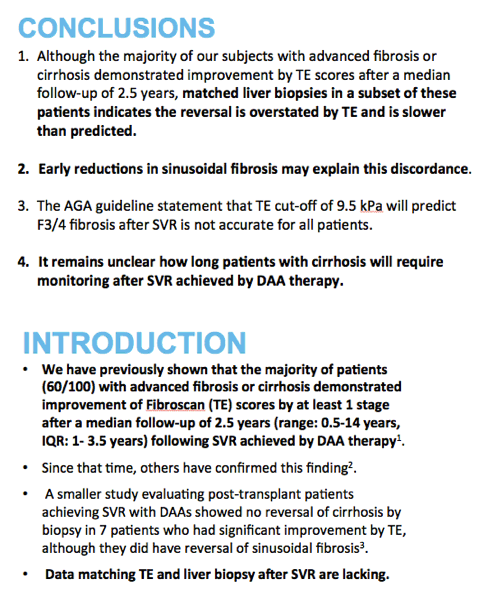
Program abstract
Background and Aims: We have previously shown that the majority of patients (60/100) with advanced fibrosis or cirrhosis demonstrated improvement of Fibroscan (TE) scores by at least 1 stage after a median follow-up of 2.5 years (range: 0.5-14 years, IQR: 1- 3.5 years) following SVR achieved by DAA therapy (Crissien-Martinez AM, et al. AASLD 2015). Since that time, others have confirmed this finding (Chan J, et al. IDWeek 2016). A smaller study evaluating post-transplant patients achieving SVR with DAAs showed no reversal of cirrhosis by biopsy in 7 patients who had significant improvement by TE, although they did have reversal of sinusoidal fibrosis (Donato M, et al. AASLD 2016). Data matching TE and liver biopsy after SVR are in general lacking.
Methods: Patients were consented and followed by prospective and retrospective TE and clinical data collection at 6 month intervals, for up to 7 years. Patients who achieved reversal based on TE and who had a baseline liver biopsy were offered a repeat liver biopsy to confirm the TE findings. Of the 100 patients who were eligible for analysis with at least 1 TE measurement of fibrosis, 10 had a baseline liver biopsy and a subsequent liver biopsy after demonstration of reversal by TE.
Results: Mean age was 60.7 years, 6/10 male and 9/10 non-Hispanic white. Of the 65/100 subjects who had cirrhosis at baseline, 36 (55%) demonstrated improvement by TE, with a median time to improvement (MTI) of 2.8 years (IQR 1.0-3.5). Of the 35/100 subjects who had advanced fibrosis, 24 (69%) demonstrated an MTI of 2.0 years (IQR 1.2-2.5). Liver biopsies in 10 patients confirmed reversal of fibrosis found by TE in both groups but to a significantly lesser degree than predicted by TE. 4/9 patients with TE <9.5 kPa still had F3 or F4 on biopsy. The MTI by biopsy was 4.75 years vs. the average MTI of 2.5 years by TE. There were major reductions in sinusoidal fibrosis noted in 7/10 patients. APRI and FIB4 showed significant reductions in 7/10 and 5/10 patients respectively.
Conclusions: Although the majority of our subjects with advanced fibrosis or cirrhosis demonstrated improvement by TE scores after a median follow-up of 2.5 years, matched liver biopsies in a subset of these patients indicates the reversal is overstated by TE and is slower than predicted. Early reductions in sinusoidal fibrosis may explain this discordance. It remains unclear how long patients with cirrhosis will require monitoring after SVR achieved by DAA therapy.
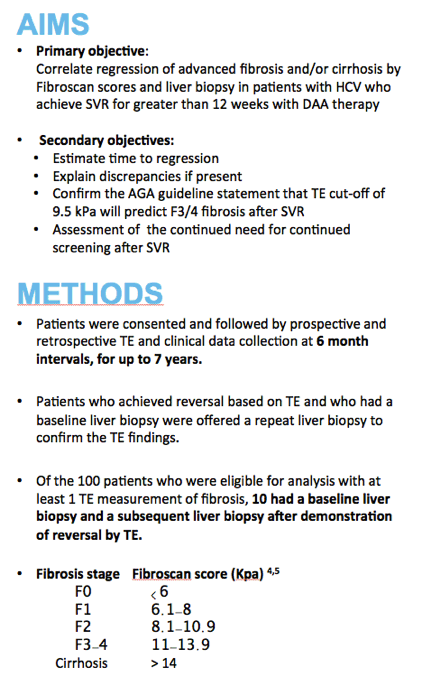
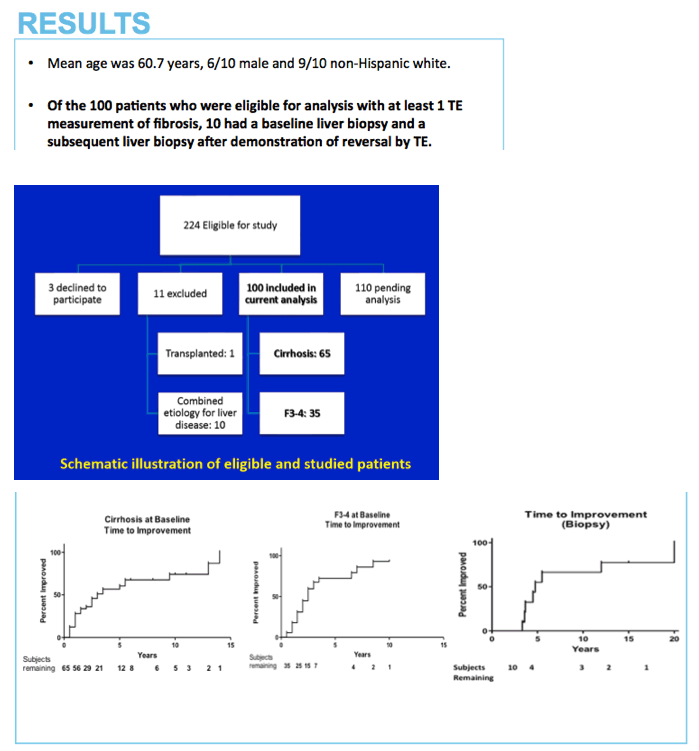
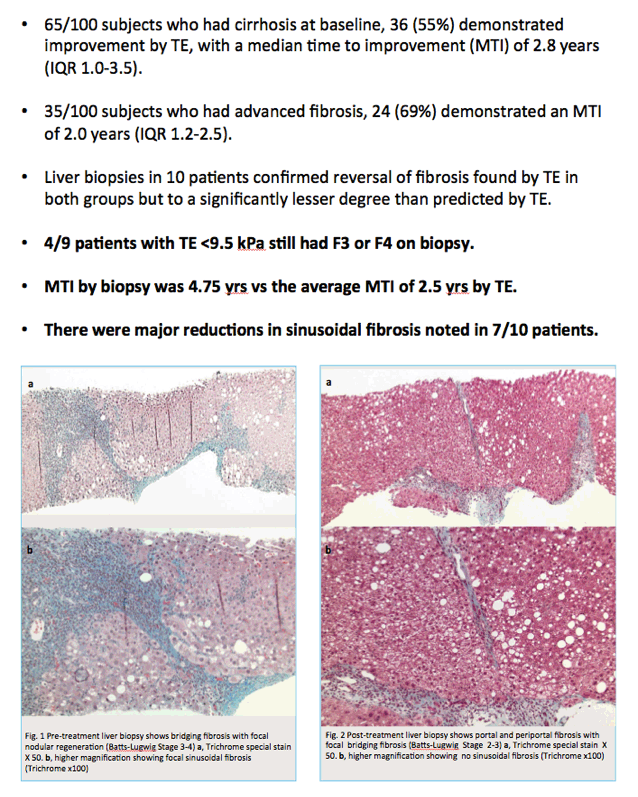
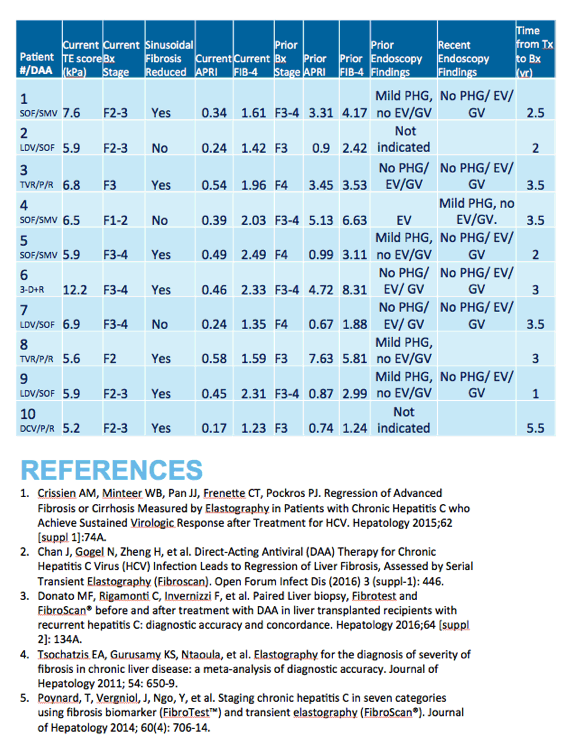
|
| |
|
 |
 |
|
|